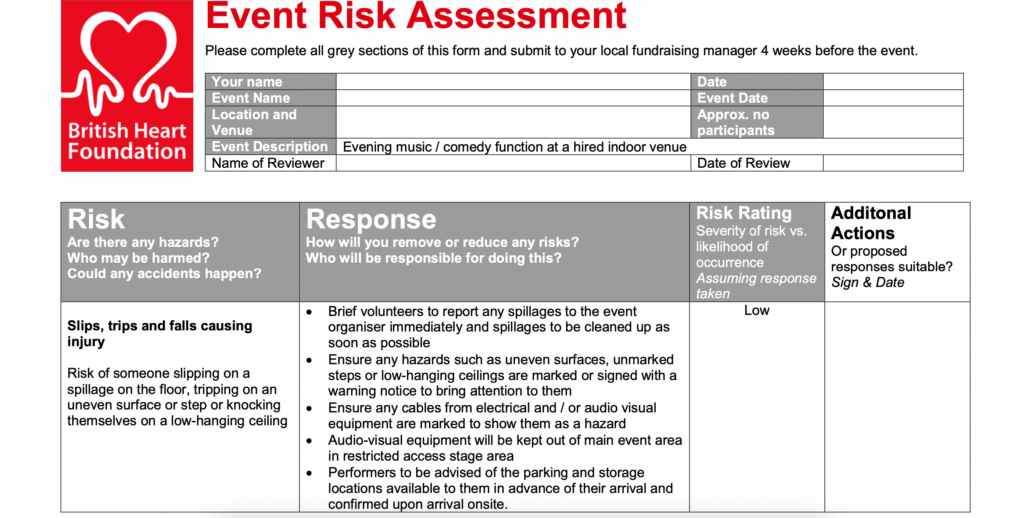What is a risk assessment?
‘A risk assessment is the process of identifying what hazards currently exist or may appear in the workplace. A risk assessment defines which workplace hazards are likely to cause harm to employees and visitors.’ (National, 2021)
A risk assessment consists of several different elements, including; hazards (electrical safety, fire safety, injury etc.), tasks (maintenance work, dealing with public), and organisation factors (working hours, shift patterns etc.) (National, 2021). They must be conducted by every employer or company.

Here is an example of a risk assessment form for an event being run by the British Heart Foundation, nothing any potential hazards and how they have been removed or reduced.
A risk assessment should be done for every event to ensure the health and welfare of any visitors and participants. They can be done by the event organiser themselves if they feel confident enough doing so, or a health and safety expert can be hired to assist or conduct the assessment. (Gov, No Date)
what to include within a risk assessment
- The activity – What is the event? Is there more than one activity taking place?
- Hazards – What could cause potential harm? Who is at risk?
- Risk – What is the likelihood of this taking place?
Hazards
| Potential Hazards | How they may be caused | How they can be resolved |
| Slips and trips | uneven flooring, low lighting, loose objects | use suitable, even flooring, tape down any loose cables or fixtures, keep public away from low lit areas |
| Collisions | same route for vehicles and pedestrians, machinery | separate vehicle routes, clearly defined pedestrian areas, suitable guarding on machinery |
| Equipment failure | poor maintenance, equipment not fit for purpose, inadequate training on equipment | ensure equipment has been tested, equipment is suitable for intended purpose, ensure people using equipment are competent |
| Falls from heights | use of ladders, performers on high stages | ensure stage is of an appropriate height, with edge protection if necessary |
| Crowds | overcrowding in areas | capped venue capacity |
| Noise | music | implement sound insulation measures, monitor noise levels |
PAT Testing
What is PAT Testing?
‘Portable Appliance Testing or PAT Testing is the process of checking electrical appliances for safety through a series of visual inspections and electronic tests.’ (Safety First, No Date)
While regulations don’t specify how often electrical appliances should be tested, all electronic equipment should be maintained in a safe condition. If equipment is used frequently, then regular tests are advised to take place. (Executive, No Date) Keeping labels on tested equipment is an easy way to monitor which equipment has been tested, and when.
Sound levels
Loud noise from a variety of sources (speakers, music etc.) can have long term effects on hearing. Long exposure to this may result in hearing loss, or other impairments. Therefore, it is important to follow safety regulations to limit the amount of loud noise exposure. The Control of Noise at Work Regulations 2005 requires employers to ensure that their employees are protected from exposure to excessive noise levels (85dB for over 8 hours) that could have a detrimental effect upon their hearing. (BBC, 2022)
A pre-event noise risk assessment is advised to take place, which may include:
- The selection of a suitable location
- Having a balanced musician lineup
- Selecting an appropriate stage design
- Monitoring the PA and amplification used within the event
- Sound checks and rehearsals
(HSE, No Date)
how to control noise exposure – staff
- Identify where there may be a risk
- Consider what action needs to be taken
- Reduce noise levels, or limit the time
- Ensure necessary hearing protection is provided to any staff/volunteers
- Have quiet places available
(BBC, 2022)
How to control noise exposure – audience
Most audience members are unlikely to attend regular enough events that audio exposure should become a problem. However, loud events may contribute to the noise exposure they receive throughout their life. Where possible, audience members should be at least 3 meters away from loud speakers, and should never be less than 1 meter away. Efforts should be made to keep the audience exposure under 96dB.
(BBC, 2022)
how to control noise exposure – stage
- Substituting amps and instruments for quieter ones
- Increase distance from noisier instruments (ie. drum kit)
- Position speakers for maximum ease of listening to the player
- Use technology which eliminates the need for loud backline speakers (such as a DI box)
- Use risers to separate the band
- Try dampening the drum kit using cloths, or sound absorbent materials
(HSE, No Date)
capacity
Event capacity can vary depending on how the space is being utilised. For example, will audience members be standing or seated? Generally, more audience members can fit in a space if standing. However, this may not be the most ideal depending on the event and attendees. It is best practise to check how many people are likely to attend your event, and see how much space you have, and plan accordingly. Or, if space is limited. Planning what the capacity is beforehand will allow you to cap the venue’s tickets.